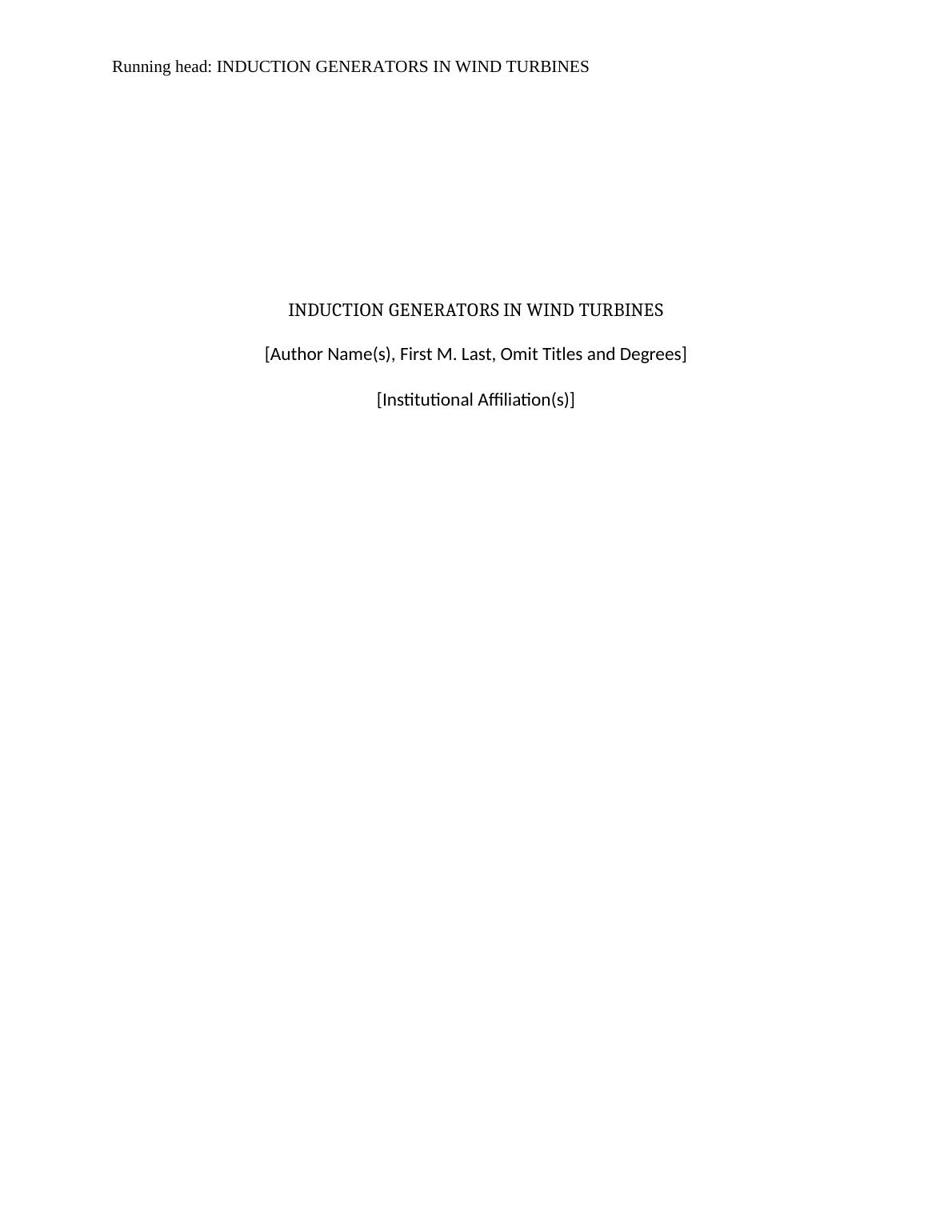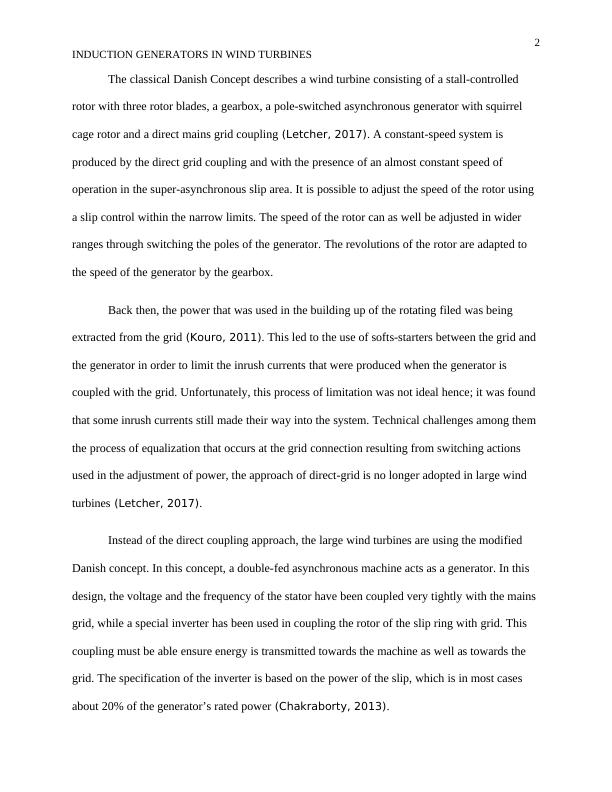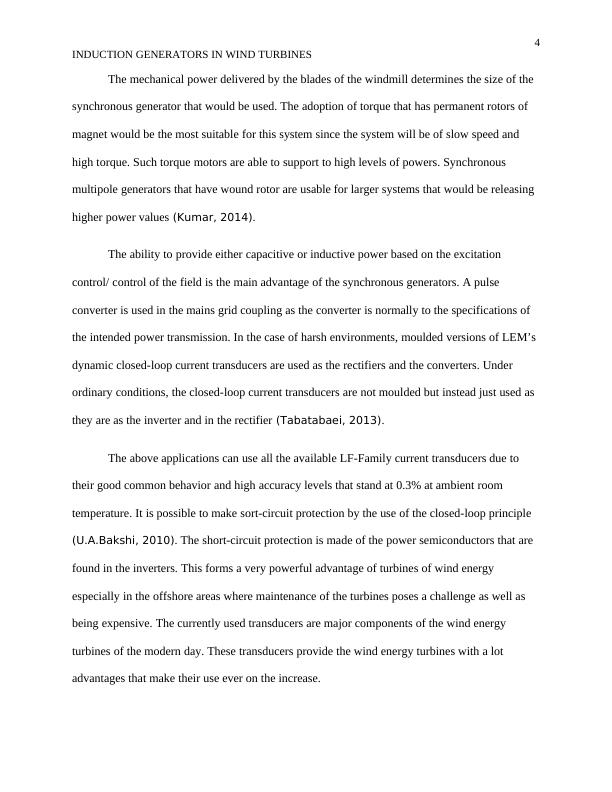Induction Generations in Wind Turbines
11 Pages2295 Words134 Views
Added on 2020-05-16
Induction Generations in Wind Turbines
Added on 2020-05-16
ShareRelated Documents
Running head: INDUCTION GENERATORS IN WIND TURBINES
INDUCTION GENERATORS IN WIND TURBINES
[Author Name(s), First M. Last, Omit Titles and Degrees]
[Institutional Affiliation(s)]
INDUCTION GENERATORS IN WIND TURBINES
[Author Name(s), First M. Last, Omit Titles and Degrees]
[Institutional Affiliation(s)]

2
INDUCTION GENERATORS IN WIND TURBINES
The classical Danish Concept describes a wind turbine consisting of a stall-controlled
rotor with three rotor blades, a gearbox, a pole-switched asynchronous generator with squirrel
cage rotor and a direct mains grid coupling (Letcher, 2017). A constant-speed system is
produced by the direct grid coupling and with the presence of an almost constant speed of
operation in the super-asynchronous slip area. It is possible to adjust the speed of the rotor using
a slip control within the narrow limits. The speed of the rotor can as well be adjusted in wider
ranges through switching the poles of the generator. The revolutions of the rotor are adapted to
the speed of the generator by the gearbox.
Back then, the power that was used in the building up of the rotating filed was being
extracted from the grid (Kouro, 2011). This led to the use of softs-starters between the grid and
the generator in order to limit the inrush currents that were produced when the generator is
coupled with the grid. Unfortunately, this process of limitation was not ideal hence; it was found
that some inrush currents still made their way into the system. Technical challenges among them
the process of equalization that occurs at the grid connection resulting from switching actions
used in the adjustment of power, the approach of direct-grid is no longer adopted in large wind
turbines (Letcher, 2017).
Instead of the direct coupling approach, the large wind turbines are using the modified
Danish concept. In this concept, a double-fed asynchronous machine acts as a generator. In this
design, the voltage and the frequency of the stator have been coupled very tightly with the mains
grid, while a special inverter has been used in coupling the rotor of the slip ring with grid. This
coupling must be able ensure energy is transmitted towards the machine as well as towards the
grid. The specification of the inverter is based on the power of the slip, which is in most cases
about 20% of the generator’s rated power (Chakraborty, 2013).
INDUCTION GENERATORS IN WIND TURBINES
The classical Danish Concept describes a wind turbine consisting of a stall-controlled
rotor with three rotor blades, a gearbox, a pole-switched asynchronous generator with squirrel
cage rotor and a direct mains grid coupling (Letcher, 2017). A constant-speed system is
produced by the direct grid coupling and with the presence of an almost constant speed of
operation in the super-asynchronous slip area. It is possible to adjust the speed of the rotor using
a slip control within the narrow limits. The speed of the rotor can as well be adjusted in wider
ranges through switching the poles of the generator. The revolutions of the rotor are adapted to
the speed of the generator by the gearbox.
Back then, the power that was used in the building up of the rotating filed was being
extracted from the grid (Kouro, 2011). This led to the use of softs-starters between the grid and
the generator in order to limit the inrush currents that were produced when the generator is
coupled with the grid. Unfortunately, this process of limitation was not ideal hence; it was found
that some inrush currents still made their way into the system. Technical challenges among them
the process of equalization that occurs at the grid connection resulting from switching actions
used in the adjustment of power, the approach of direct-grid is no longer adopted in large wind
turbines (Letcher, 2017).
Instead of the direct coupling approach, the large wind turbines are using the modified
Danish concept. In this concept, a double-fed asynchronous machine acts as a generator. In this
design, the voltage and the frequency of the stator have been coupled very tightly with the mains
grid, while a special inverter has been used in coupling the rotor of the slip ring with grid. This
coupling must be able ensure energy is transmitted towards the machine as well as towards the
grid. The specification of the inverter is based on the power of the slip, which is in most cases
about 20% of the generator’s rated power (Chakraborty, 2013).

3
INDUCTION GENERATORS IN WIND TURBINES
Fig. 2. One-phase SCIG equivalent circuit in the Phaser diagram
A wind turbine of such a design has a system with variable speed from the sub-
synchronous all the way to the super-asynchronous area. The converter used in this concept is
two identical IGTB-inverters, which are controlled by a pulse that has a Dc link voltage.
Controlling the power of the grid requires swift and precise detection of current. Besides the DC
voltage link used with the IGTB inverters, closed-loop current transducers can also be used to
serve a similar purpose but when using the transducers, care must be taken to ensure the current
ratings of the transducers are at medium (Freris, 2008). The transducers need to be available
with varied mounting styles, be compact as well as possess and ability to both controls and/or
monitor the DC link voltage.
Synchronous generator and grid coupling
The above-described concept makes us of the gearbox to adapt to the rotor’s slow
revolutions to the speed of the generator. A synchronous generator can also be used in the
provision of wind energy turbine of variable speed. Such is a well part of the Danish concept
(Jain, 2010). The lower speed of the rotor is being used in deriving the adaptations of the
revolutions of the rotor to the speed of the generator. This is so because of the intensive
maintenance of gearbox and the mechanical losses that is associated with it that renders its use
less significant.
INDUCTION GENERATORS IN WIND TURBINES
Fig. 2. One-phase SCIG equivalent circuit in the Phaser diagram
A wind turbine of such a design has a system with variable speed from the sub-
synchronous all the way to the super-asynchronous area. The converter used in this concept is
two identical IGTB-inverters, which are controlled by a pulse that has a Dc link voltage.
Controlling the power of the grid requires swift and precise detection of current. Besides the DC
voltage link used with the IGTB inverters, closed-loop current transducers can also be used to
serve a similar purpose but when using the transducers, care must be taken to ensure the current
ratings of the transducers are at medium (Freris, 2008). The transducers need to be available
with varied mounting styles, be compact as well as possess and ability to both controls and/or
monitor the DC link voltage.
Synchronous generator and grid coupling
The above-described concept makes us of the gearbox to adapt to the rotor’s slow
revolutions to the speed of the generator. A synchronous generator can also be used in the
provision of wind energy turbine of variable speed. Such is a well part of the Danish concept
(Jain, 2010). The lower speed of the rotor is being used in deriving the adaptations of the
revolutions of the rotor to the speed of the generator. This is so because of the intensive
maintenance of gearbox and the mechanical losses that is associated with it that renders its use
less significant.

4
INDUCTION GENERATORS IN WIND TURBINES
The mechanical power delivered by the blades of the windmill determines the size of the
synchronous generator that would be used. The adoption of torque that has permanent rotors of
magnet would be the most suitable for this system since the system will be of slow speed and
high torque. Such torque motors are able to support to high levels of powers. Synchronous
multipole generators that have wound rotor are usable for larger systems that would be releasing
higher power values (Kumar, 2014).
The ability to provide either capacitive or inductive power based on the excitation
control/ control of the field is the main advantage of the synchronous generators. A pulse
converter is used in the mains grid coupling as the converter is normally to the specifications of
the intended power transmission. In the case of harsh environments, moulded versions of LEM’s
dynamic closed-loop current transducers are used as the rectifiers and the converters. Under
ordinary conditions, the closed-loop current transducers are not moulded but instead just used as
they are as the inverter and in the rectifier (Tabatabaei, 2013).
The above applications can use all the available LF-Family current transducers due to
their good common behavior and high accuracy levels that stand at 0.3% at ambient room
temperature. It is possible to make sort-circuit protection by the use of the closed-loop principle
(U.A.Bakshi, 2010). The short-circuit protection is made of the power semiconductors that are
found in the inverters. This forms a very powerful advantage of turbines of wind energy
especially in the offshore areas where maintenance of the turbines poses a challenge as well as
being expensive. The currently used transducers are major components of the wind energy
turbines of the modern day. These transducers provide the wind energy turbines with a lot
advantages that make their use ever on the increase.
INDUCTION GENERATORS IN WIND TURBINES
The mechanical power delivered by the blades of the windmill determines the size of the
synchronous generator that would be used. The adoption of torque that has permanent rotors of
magnet would be the most suitable for this system since the system will be of slow speed and
high torque. Such torque motors are able to support to high levels of powers. Synchronous
multipole generators that have wound rotor are usable for larger systems that would be releasing
higher power values (Kumar, 2014).
The ability to provide either capacitive or inductive power based on the excitation
control/ control of the field is the main advantage of the synchronous generators. A pulse
converter is used in the mains grid coupling as the converter is normally to the specifications of
the intended power transmission. In the case of harsh environments, moulded versions of LEM’s
dynamic closed-loop current transducers are used as the rectifiers and the converters. Under
ordinary conditions, the closed-loop current transducers are not moulded but instead just used as
they are as the inverter and in the rectifier (Tabatabaei, 2013).
The above applications can use all the available LF-Family current transducers due to
their good common behavior and high accuracy levels that stand at 0.3% at ambient room
temperature. It is possible to make sort-circuit protection by the use of the closed-loop principle
(U.A.Bakshi, 2010). The short-circuit protection is made of the power semiconductors that are
found in the inverters. This forms a very powerful advantage of turbines of wind energy
especially in the offshore areas where maintenance of the turbines poses a challenge as well as
being expensive. The currently used transducers are major components of the wind energy
turbines of the modern day. These transducers provide the wind energy turbines with a lot
advantages that make their use ever on the increase.

End of preview
Want to access all the pages? Upload your documents or become a member.
Related Documents
Wind Turbines Induction Generators (Doc)lg...
|14
|2434
|679
Power Electronics : Assignmentlg...
|3
|729
|162
Theoretical Background Electrical Engineeringlg...
|9
|1452
|51
How Wind Turbines Generate Electricitylg...
|31
|14391
|64
Advance Electrical Machines and Driveslg...
|39
|6447
|5
Electrical Power & Drive Systems - Doclg...
|25
|2031
|44
